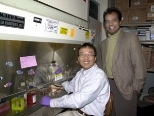A young MIT professor's basic research on complex sugars has led to a cascade of potential medical applications that could, for example, significantly improve outcomes for patients undergoing major operations such as heart bypass surgery and impact a multibillion dollar drug industry.
In the online edition of the Proceedings of the National Academy of Sciences (PNAS) for the week of Jan. 13, a team led by the professor, Ram Sasisekharan, reports the creation of designer drugs for preventing the blood clots that can cause strokes and heart disease during surgery. The resulting drugs have major advantages over the conventional form they are based on, which has an annual market of $2-3 billion. Further, an additional drug based on Sasisekharan's work is presently in Phase III clinical trials for heart bypass patients.
For more than 60 years, doctors have used the drug heparin--the focus of the current research--during surgeries. Although safe, heparin and its smaller cousin, low-molecular-weight heparin, have shortcomings that limit their applications.
Those shortcomings are based on the fact that there's been no quick and easy way to determine the exact amounts of the active ingredients of the drugs. "Simply put, low-molecular-weight heparins are essentially generated by chopping up heparin in a blender, which results in a mixture of large and small pieces with different amounts of active sites, or areas key to anticoagulation," said Sasisekharan, an associate professor in the Biological Engineering Division. As a result, the drugs' strengths vary from product to product and even from batch to batch.
If, on the other hand, scientists knew the structure of those active ingredients and had the tools to clip out only those sites from the bulk material, they could create more effective drugs.
The MIT research reported in PNAS does just that.
"This work started out as fundamental studies on complex sugars and has led to what may become an important new drug to treat conditions such as heart disease. It is an outstanding example of how basic research leads to cutting-edge technologies and medical advances," said Pamela Marino, a biochemist and program director for glycobiology at the National Institute of General Medical Sciences, which partially supported the research.
It began with Sasisekharan's creation in 1992 of a ready supply of the molecular scissors, or heparinases, necessary to "tailor" the heparins. He did so by cloning the heparinase gene, working with MIT professors Robert S. Langer and Charles L. Cooney. That accomplishment, too, was reported in PNAS.
Since then, Sasisekharan joined the MIT faculty, and with his graduate students and staff has used the heparinase scissors in several studies with wide-ranging implications. First, the team developed a powerful technique for determining the order of building blocks in complex sugars like heparin (MIT Tech Talk, Oct. 20, 1999). That tool, in turn, led to insights on heparin's active sites (MIT Tech Talk, Sept. 13, 2000). Another study showed that cells' sugar jackets can be tailored to prevent cancer (MIT Tech Talk, Jan. 30, 2002).
In the current PNAS paper, the team reports the creation of two "designer" forms of low-molecular-weight heparin (LMWH), each with specially engineered properties, or activity profiles. They show that in rats the new formulations are much more potent and hence effective than conventional forms of the drug. The new LMWH formulations can also be rapidly neutralized in the body, unlike their LMWH predecessors, opening up additional applications.
"The ability to develop low molecular weight heparin fragments with specific activity profiles represents an important advance in our understanding of how heparin and related compounds work as anticoagulants," said Dr. Elliott M. Antman, an expert in the heparin field and director of the Coronary Care Unit at Brigham and Women's Hospital. "The benefits of new designer heparin fragments now need testing in clinical trials."
Authors of the paper are from the Biological Engineering Division and Center for Biomedical Engineering. In addition to Sasisekharan they are research affiliates Mallik Sundaram, Yiwei Qi and Dongfang Liu (Ph.D. 2001); research fellow Ganlin Zhao; visiting scientists Zachary Shriver (Ph.D. 2001) and Ganesh Venkataraman (Ph.D. 1993); and Langer, the Germeshausen Professor of Chemical and Biomedical Engineering who also holds an appointment in the Department of Chemical Engineering.
One of the heparinases that Sasisekharan developed for tailoring heparin is itself the focus of clinical trials. Currently doctors use a compound called protamine to bind to inactivate heparin in the body when it is no longer needed at the end of surgery. However, "there are serious limitations to the use of protamine," Sasisekharan said. "Importantly, it binds to other molecules in the blood non-specifically, in addition to heparin, potentially causing side-effects."
Sasisekharan himself is excited--and a bit awed--by the applications that are resulting from his work. "It's very often easier said than done to translate an idea to reality," he said. "To see it happen is really a humbling experience."
A version of this article appeared in MIT Tech Talk on January 29, 2003.






